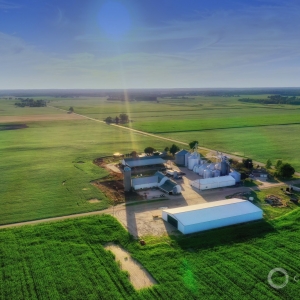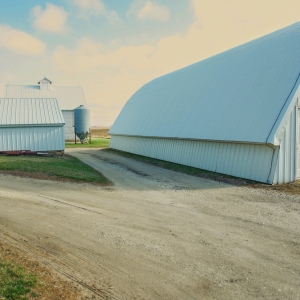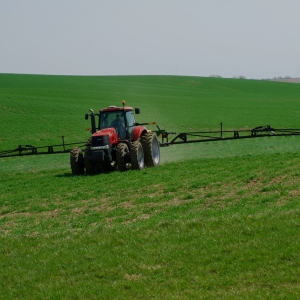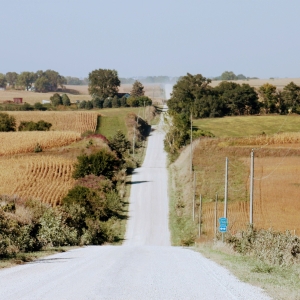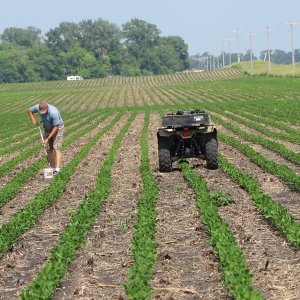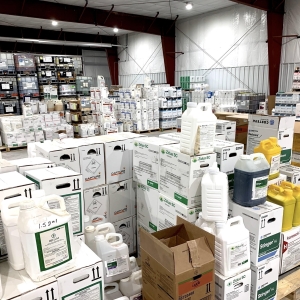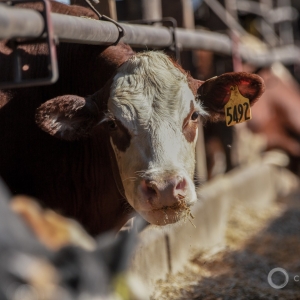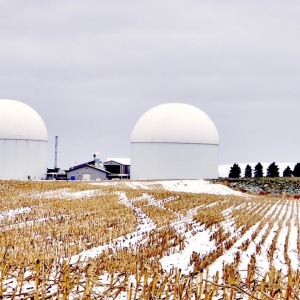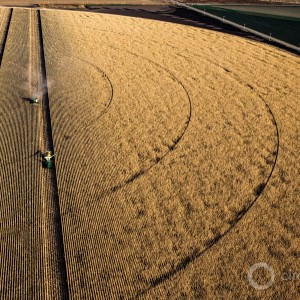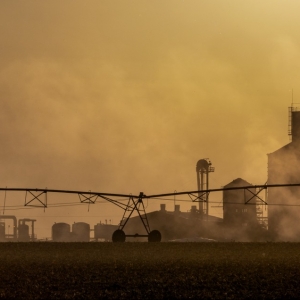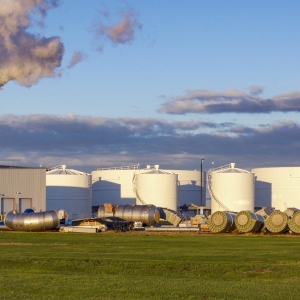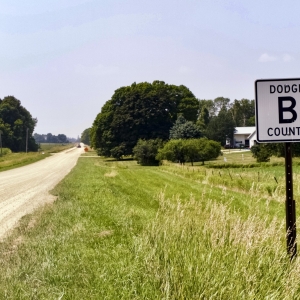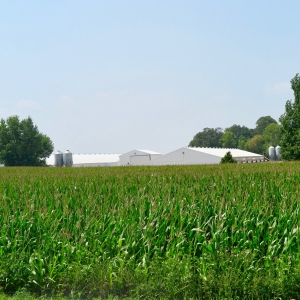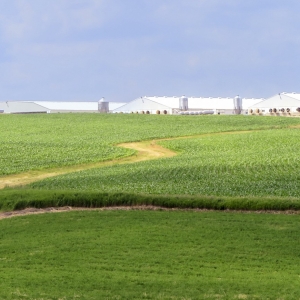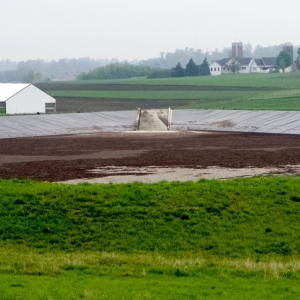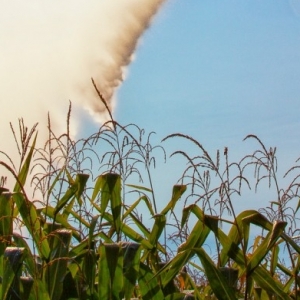
Amish Farmers’ Partnership With Beef Giant Produces Manure Mess
Water pollution found in three counties in Indiana, Ohio, and Michigan.
By Keith Schneider, Circle of Blue
November 8, 2024
EDON, OH — For 60 years, this one stoplight Ohio town has been known as a place where time appears to stand still. With more than 400 Amish residents settled in and around the rural community that straddles the Ohio, Indiana, and Michigan state lines, it is common to see large families traveling by horse-drawn black buggies to and from farms where they milk dairy cows and grow corn.
Adhering to a strict religious doctrine that resists new technology, Amish farmers here spent decades largely eschewing industrial farming practices that have become common around the United States.
But that bucolic tableau of plain people earnestly cultivating the rich soil where three states meet has ceased to exist, splintered by an industrial farm alliance between one of the area’s leading Amish farming families and JBS Foods, the world’s largest beef producer. Over the last two years, JBS has forged a partnership to establish a mammoth vertically integrated concentrated cattle feeding operation that is confining more than 100,000 male calves and steers in large concrete, steel, and vinyl-covered feeding barns, and generating thousands of tons of solid manure each day.
Prompted by persistent complaints of odor and contamination, regulators from the Ohio Agriculture Department and the state Environmental Protection Agency investigated earlier this year and cited nine farms for manure mismanagement, and issued fines to three farms for failing to secure proper operating permits.
The cited farms, most owned by the Schmucker family, are close to each other in Williams County, Ohio. Inspectors from the two state agencies found uncontained manure running off big waste piles and out of barns, and draining into streams and wetlands. Inspectors took water samples that contained high concentrations of nitrogen ammonia, a contaminant of manure.

Some 3,000 calves arrive weekly and are raised to 600-pound to 700-pound animals at Amish farms in three counties that surround Edon, Ohio. Photo © Keith Schneider/ Circle of Blue
Manure Pollution Documented
The state findings were consistent with those observed by area residents who’ve watched as Amish farmers piled manure in huge mounds, spread it on farm fields as fertilizer, and taken their own water samples that confirmed it polluted streams, lakes, and the St. Joseph River.
The widespread contamination caused a deepening schism with the community, which was unprepared for such immense agricultural industrialization and the subsequent environmental contamination.
Neither Noah Schmucker Jr., the leader of the Amish farm community, nor JBS executives agreed to be interviewed for this report. Executives of Wagler and Associates, an Indiana construction company heavily involved in building the feeding barns, declined to be interviewed.
When asked about the concerns, Ohio Department of Agriculture Director Brian Baldridge said the agency would continue to “engage with all property owners to ensure they are following Ohio laws and rules.”
What’s unfolded around this farming town of 800 residents in the far northwestern corner of Ohio is the agricultural equivalent of what occurred during the fracking boom in Williston, North Dakota in the late 2000s. Powered by new technology, vastly different production practices, and access to huge sums of capital, a new beef production industry swept into a region unaccustomed and unprepared for such immense agricultural industrialization, or its environmental contamination.
The civic restiveness here is part of a growing national movement protesting the public health and environmental consequences of wastes produced by confined animal feeding operations (CAFO) that produce most of the nation’s milk, meat, and eggs. Almost everywhere they operate discharges of manure and other wastes from CAFOS are a primary source of water pollution, according to state and federal assessments. Phosphorus from hog, dairy, and poultry CAFOs have been linked to annual toxic algal blooms in Lake Erie, Chesapeake Bay, Lake Champlain, and other iconic American waters. The tide of nitrates from CAFO wastes in Mississippi River Basin states are a major cause of the expansive dead zone in the Gulf of Mexico. The U.S. Environmental Protection Agency last summer sued three big dairies to control manure wastes contaminating groundwater in Washington state, and has directed state authorities to halt pollution from CAFO wastes in Minnesota, Wisconsin, and Oregon.
California critics put the issue to a vote in Tuesday’s general election, seeking to make Sonoma County the first in the nation to ban CAFOs, also called “factory farms”. The measure failed in the face of stiff opposition from farm and business interests.
Susan Catterall, a mother of five who lives in Hamilton, and a leader of the environmental coalition opposing the growing cattle sector, describes the astonishing size of the region’s new cattle sector. “Steuben County has 101 lakes. It’s our legacy. It our bread and butter, our tourism dollars. It’s our heritage,” she said. “It’s being spoiled. We’ve got farms polluting our county with an unbelievable amount of manure.”

State inspectors took samples and confirmed that water running into drains and ditches had elevated concentrations of ammonia, nitrogen contaminate found in manure. © J.Carl Ganter/ Circle of Blue
Trends Fostering The Partnership
Driving the new industry’s development are economic factors and limits on environmental oversight that extend well beyond this corner of three states. According to the operation’s business plan, which became public last year, Amish farms are raising male cross-bred calves born to Holstein cows from dairies in neighboring states, and sired from same sex semen of Angus bulls. Some 3,000 calves arrive weekly, are fed for several months, and 3,000 market-ready cattle weighing 600 pounds to 700 pounds leave weekly to be fattened at finishing feedyards. Their eventual destination is JBS’s processing plant in Plainwell, where an average of 1,400 cattle are slaughtered daily. Animals with 51 percent or more black hides can be marketed by JBS as higher priced certified “choice” and “prime” Angus beef.
In developing a reliable source of beef that is much closer than JBS’s suppliers in the West, the company also is competing with Wal-Mart and other corporate beef producers to perfect production practices that are weakening the nation’s range fed cattle sector.
“Vertical integration is eliminating competition in the industry,” said Bill Bullard, a former rancher in South Dakota and chief executive of R-CALF USA, an independent cattlemen’s trade association. “A vertically integrated system needs fewer farmers. That’s why we wiped out 90 percent of all the hog producers just since 1980, and why we’ve wiped out 89 percent of the dairy producers.”
“The cattle industry is really the last frontier,” he added. “We still have approximately 20 percent of cattle still marketed in an open competitive cash market or spot market. What’s at risk here is that these vertically integrated systems are going to extinguish the cash market in the cattle industry. Just in the last five years, we’ve lost nearly 107,000 independent beef cattle operations They’re dropping like flies.”
The JBS-Amish partnership is ominous for other reasons. Most of the country’s beef cattle are still raised on pasture, where manure is spread across the land and has time to incorporate in soil. The U.S. population of Amish is now nearly 400,000, and growing most rapidly in the Great Lakes states, according to the Young Center for Anabaptist and Pietist Studies at Elizabethtown College. The model JBS has established here could readily be embraced by entrepreneurial Amish communities in other states. JBS also has beef processing plants in Green Bay, Wisconsin and Souderton, Pennsylvania.

Concrete, steel, and vinyl-covered hoop barns are the favored design of feeding barns in the region. Each costs roughly $130,000 according to Steuben County permit records, Photo © J.Carl Ganter/ Circle of Blue
Confined Cattle Produce Huge Amounts of Manure
The consequences for water quality could be terrible. As the operators of any large corporate dairy or hog or poultry operation know, one of the most challenging facets of confining large numbers of farm animals is managing manure. Using standard U.S. Department of Agriculture measurements of manure produced by calves (60 pounds per day) and growing cattle (75 pounds) the Amish cattle farms here produce roughly 7 million pounds — 3,500 tons — of manure daily.
Just as in Iowa, Minnesota, Nebraska, North Carolina, Missouri and other states that support large industrialized livestock and poultry sectors, concentrated feeding operations are major polluters. Water samples collected by the Steuben County Lakes Council and the Williams County Alliance, two environmental groups, show persistently high concentrations of nitrates, phosphorus, and dangerous E-coli bacteria in streams and lakes in the region that encompass the St. Joseph River watershed. The river serves Fort Wayne with its drinking water, and drains into the Maumee River, the primary source of the pollutants that cause a mammoth annual toxic algae bloom in Lake Erie. The groups also tracked the contamination upstream headwaters of Fish Creek and Black Creek. Both flow through the Amish cattle farms.
The situation outrages Sandy Bihn, executive director of Lake Erie Waterkeeper, who has worked for decades on regional, national, and binational groups to cure the lake’s annual toxic bloom.
“How is it possible to let 100,000 animals, and all the nitrates and phosphorus that they produce, come into the watershed that we’re investing millions and millions of dollars, if not billions of dollars to protect?” Bihn said. “This just shows how meat and JBS are able to control the system.”
While the buggies, beards, and plain dress still help to identify Amish farms in Williams County and the two neighboring counties, there is nothing characteristically Amish about the vertically integrated, industrial scale, scientifically advanced calf and cattle production system that has quickly evolved here.
The financial advantage is plain for the Schmuckers and the other Amish farmers. The most labor intensive aspect of the Amish cattle operation is feeding and caring for calves. Amish families are large. There are plenty of hands available for the work. Latino laborers also are employed to help with animal care and operate the skidders that push manure out of the barns. Judging by the number of new homes, new cattle confinement facilities, and the prices Amish are paying for farmland – $14,000 to $20,000 an acre, according to county records –business is lucrative.

Millions of pounds of manure are generated daily and transported to dump sites and fields near Edon Ohio (photo Keith Schnieider)© Keith Schneider photo/ Circle of Blue
A Hearing Alerts Residents
The civic confrontation between the Amish and English communities started in December 2023 when Noah Schmucker and Wagler and Associates sought a permit to build a $10 million feeding facility for 8,000 calves and cattle in Steuben County. It was the first time the scale of the operation and JBS’s involvement was publicly revealed. Schmucker baldly stated at the hearing that if the county refused the permit he would just build smaller feeding barns that evaded county and state permitting requirements. Ohio does not require a permit unless a barn houses over 1,000 animals. Indiana’s limit is 300.
Hundreds of residents, many of them owners of lakeside homes, protested both options, fearing water pollution from manure. The county rejected the permit, prompting Schmucker to proceed with subdividing land and construction.
Evidence of the industry’s presence, and its profitability, is everywhere now around Edon. Dozens of big concrete, steel, and vinyl cattle feeding barns have already been built, each costing $130,000 or more, and many others are under construction. Trucks hauling calves and cattle crowd the highways and the narrow dirt farm-to-market roads. New Amish homes are under construction. Manure piles rest like sleeping beasts beside confinement barns. Trucks loaded with manure head for dumping sites. The entire region’s scent is an invisible and noxious veil of cattle wastes.
Following persistent complaints of from residents of pollution and odor state environmental and agriculture authorities in the three states inspected many of the Amish farms. Michigan authorities directed a calf feeding operation to halt the flow of manure draining into a stream that fed a nearby lake. Inspectors from Indiana’s Agriculture Department inspected a Steuben County farm and found that it was in compliance with state rules.
The Ohio Environmental Protection Agency cited nine Amish farms for violations of manure management regulations in August and set a September 1 deadline for fixing them that the farms met. Ohio authorities discovered several feeding sites where the number of cattle exceeded 1,000 animals, and the farms have since some into compliance. The state also ordered the largest mounds of manure, some towering two and three stories tall, to be removed.
The Ohio Agriculture Department issued $20,000 in fines to three Amish farms for failing to acquire the proper state permits.
Ohio’s action reflects the limited reach of state environmental law to control agricultural contamination. Though modest, the state’s enforcement is the most aggressive against farm pollution since 1999, when Ohio cited an egg farm for fouling water with chicken litter.
Not yet clear is whether it will have any effect on water quality.
“What’s happening is that JBS is taking advantage of lesser environmental requirements and just simply exploiting the situation,” said Bill Bullard, the South Dakota rancher and executive.
The New Lede published a version of this article on November 8, 2024.
Featured Image: Photo © J.Carl Ganter/ Circle of Blue





